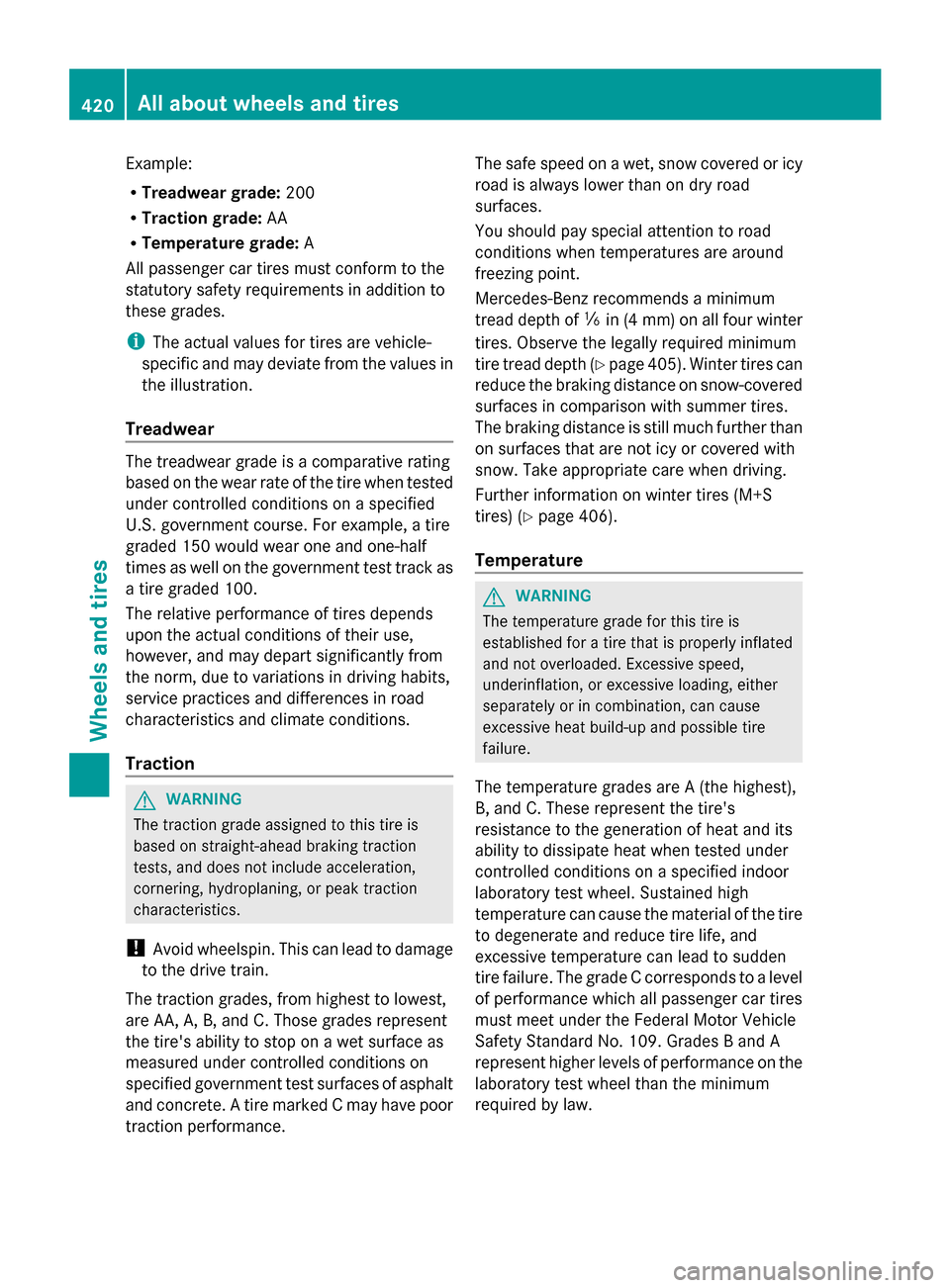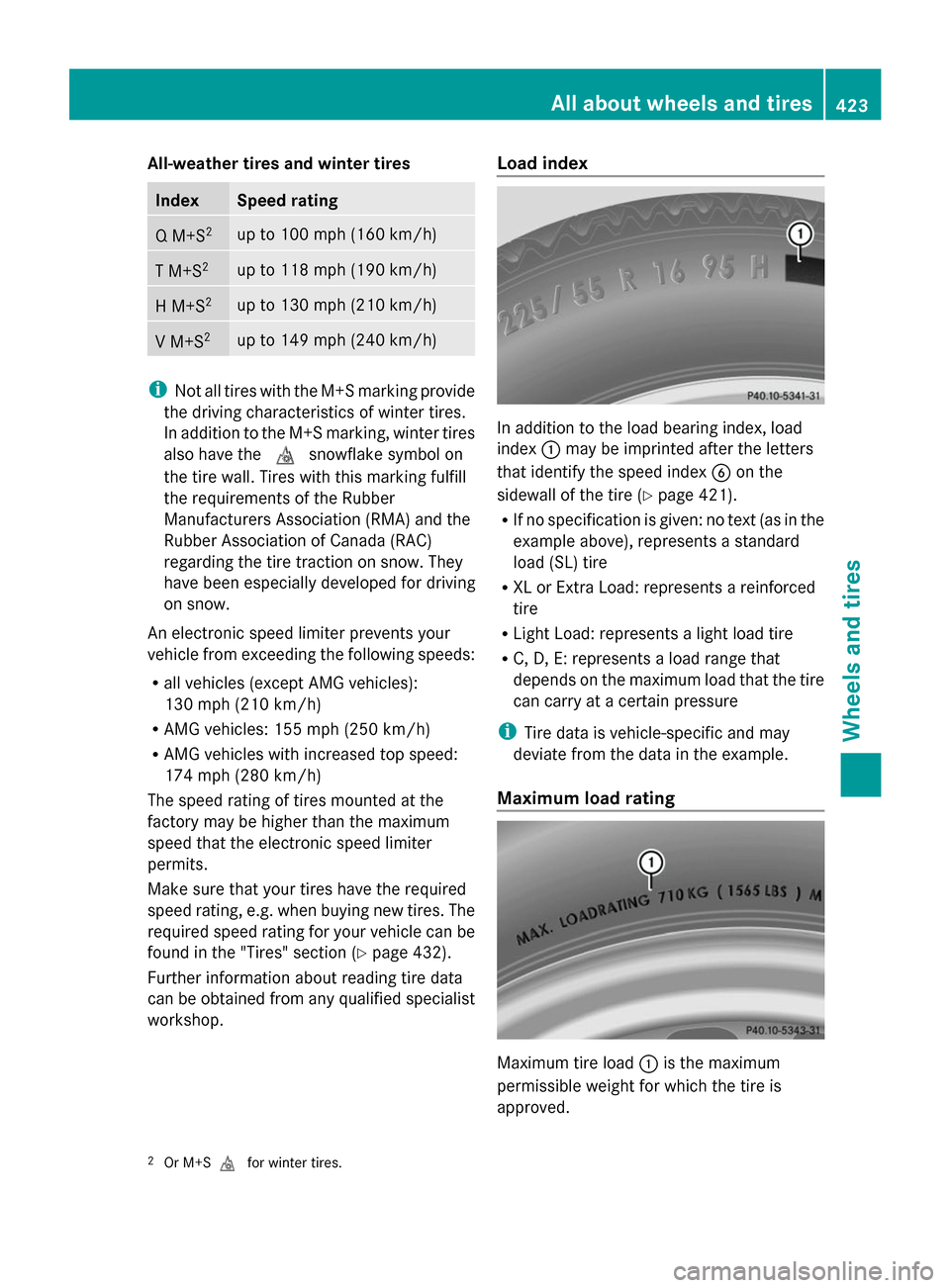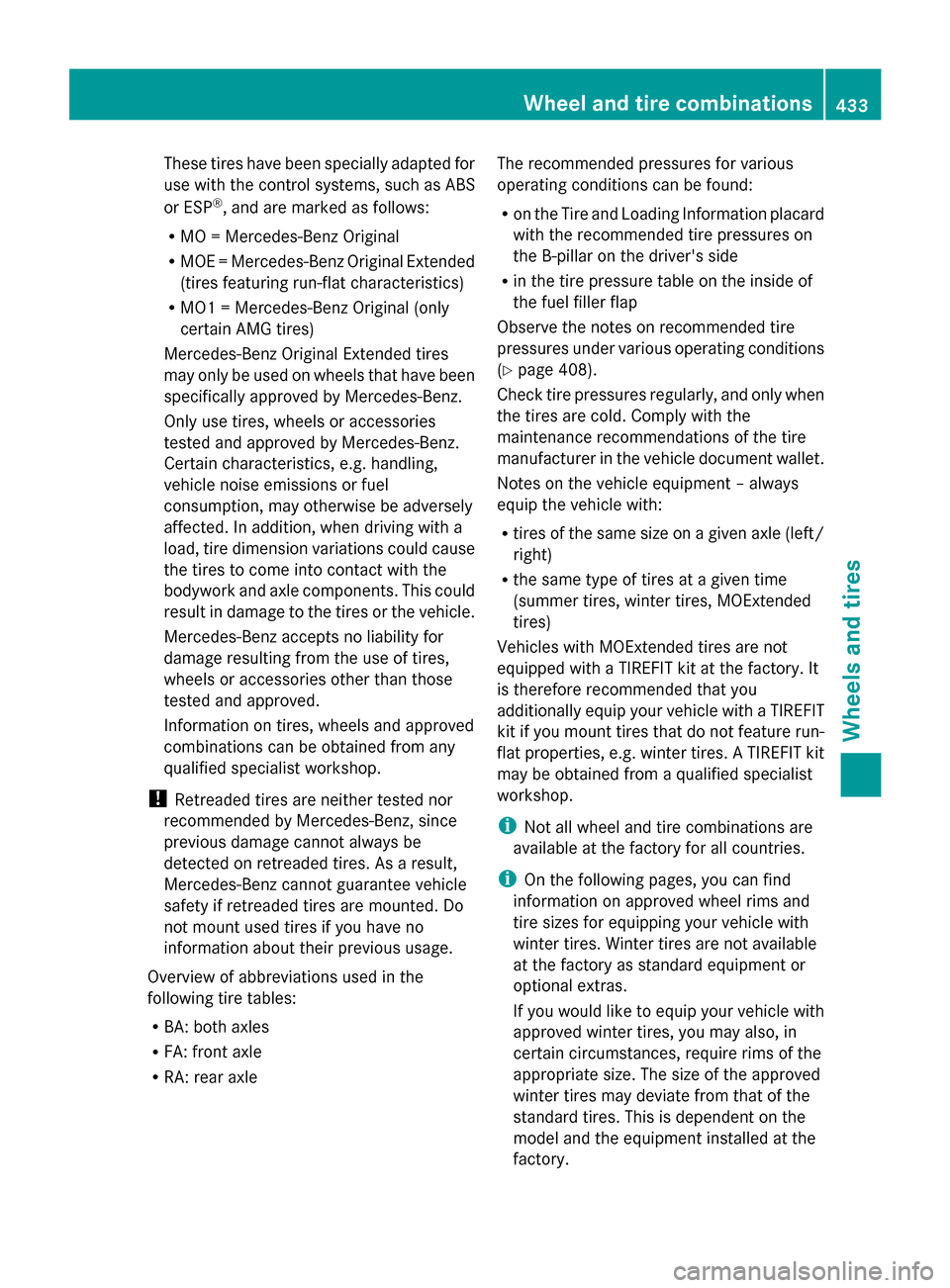2014 MERCEDES-BENZ GL-Class winter tires
[x] Cancel search: winter tiresPage 409 of 462

Only winter tires bearing the
isnowflake
symbol in addition to the M+S marking
provide the best possible grip in wintry road
conditions.
Only these tires will allow driving safety
systems such as ABS and ESP ®
to function
optimally in winter. These tires have been
developed specifically for driving in snow.
Use M+S tires of the same make and tread on
all wheels to maintain safe handling
characteristics.
Always observe the maximum permissible
speed specified for the M+S tires you have
mounted.
Once the winter tires are mounted:
X Check the tire pressures (Y page 411).
X Restart the tire pressure monitor
(Y page 412).
X Vehicles for Canada: restart the tire
pressure loss warning system
(Y page 412).
For more information on driving with the
emergency spare wheel, see (Y page 439).Snow chains
G
WARNING
If snow chains are installed to the front
wheels, they may drag against the vehicle
body or chassis components. This could
cause damage to the vehicle or the tires.
There is a risk of an accident.
To avoid hazardous situations:
R never install snow chains to the front
wheels
R always install snow chains in pairs to the
rear wheels.
! You must drive at raised vehicle level
(height 1) if snow chains have been
installed. The vehicle may otherwise be
damaged.
! Vehicles with Adaptive Damping
System (ADS): do not use the sports mode if you have installed snow chains. The
vehicle may otherwise be damaged.
! On some tire sizes there is not enough
space for snow chains. To avoid damage to
the vehicle or tires, observe the "Wheel and
tire combinations" section under "Tires and
wheels".
For safety reasons, Mercedes-Benz
recommends that you only use snow chains
that have been specially approved for your
vehicle by Mercedes-Benz, or are of a
corresponding standard of quality.
If you intend to mount snow chains, please
bear the following points in mind:
R Only use snow chains when driving on
roads completely covered by snow.
Remove the snow chains as soon as
possible when you come to a road that is
not snow-covered.
R Do not exceed the maximum permissible
speed of 30 mph (50 km/h).
R Local regulations may restrict the use of
snow chains. Observe the appropriate
regulations if you wish to mount snow
chains.
R Snow chains may not be mounted on all
wheel/tire combinations. Permissible
wheel-tire combinations (Y page 432).
i You may wish to deactivate ESP ®
(Y page 73) when pulling away with snow
chains installed. You can thereby allow the
wheels to spin in a controlled manner,
achieving an increased driving force
(cutting action).
For more information on driving with the
emergency spare wheel, see (Y page 439). Winter operation
407Wheels and tires Z
Page 422 of 462

Example:
R
Treadwear grade: 200
R Traction grade: AA
R Temperature grade: A
All passenger car tires must conform to the
statutory safety requirements in addition to
these grades.
i The actual values for tires are vehicle-
specific and may deviate from the values in
the illustration.
Treadwear The treadwear grade is a comparative rating
based on the wear rate of the tire when tested
under controlled conditions on a specified
U.S. government course. For example, a tire
graded 150 would wear one and one-half
times as well on the government test track as
a tire graded 100.
The relative performance of tires depends
upon the actual conditions of their use,
however, and may depart significantly from
the norm, due to variations in driving habits,
service practices and differences in road
characteristics and climate conditions.
Traction G
WARNING
The traction grade assigned to this tire is
based on straight-ahead braking traction
tests, and does not include acceleration,
cornering, hydroplaning, or peak traction
characteristics.
! Avoid wheelspin. This can lead to damage
to the drive train.
The traction grades, from highest to lowest,
are AA, A, B, and C. Those grades represent
the tire's ability to stop on a wet surface as
measured under controlled conditions on
specified government test surfaces of asphalt
and concrete. A tire marked C may have poor
traction performance. The safe speed on a wet, snow covered or icy
road is always lower than on dry road
surfaces.
You should pay special attention to road
conditions when temperatures are around
freezing point.
Mercedes-Benz recommends a minimum
tread depth of
ãin(4 mm) on all four winter
tires. Observe the legally required minimum
tire tread depth (Y page 405). Winter tires can
reduce the braking distance on snow-covered
surfaces in comparison with summer tires.
The braking distance is still much further than
on surfaces that are not icy or covered with
snow. Take appropriate care when driving.
Further information on winter tires (M+S
tires) (Y page 406).
Temperature G
WARNING
The temperature grade for this tire is
established for a tire that is properly inflated
and not overloaded. Excessive speed,
underinflation, or excessive loading, either
separately or in combination, can cause
excessive heat build-up and possible tire
failure.
The temperature grades are A (the highest),
B, and C. These represent the tire's
resistance to the generation of heat and its
ability to dissipate heat when tested under
controlled conditions on a specified indoor
laboratory test wheel. Sustained high
temperature can cause the material of the tire
to degenerate and reduce tire life, and
excessive temperature can lead to sudden
tire failure. The grade C corresponds to a level
of performance which all passenger car tires
must meet under the Federal Motor Vehicle
Safety Standard No. 109. Grades B and A
represent higher levels of performance on the
laboratory test wheel than the minimum
required by law. 420
All about wheels and tiresWheels and tires
Page 425 of 462

All-weather tires and winter tires
Index Speed rating
Q M+S
2 up to 100 mph (160 km/h)
T M+S
2 up to 118 mph (190 km/h)
H M+S
2 up to 130 mph (210 km/h)
V M+S
2 up to 149 mph (240 km/h)
i
Not all tires with the M+S marking provide
the driving characteristics of winter tires.
In addition to the M+S marking, winter tires
also have the isnowflake symbol on
the tire wall. Tires with this marking fulfill
the requirements of the Rubber
Manufacturers Association (RMA) and the
Rubber Association of Canada (RAC)
regarding the tire traction on snow. They
have been especially developed for driving
on snow.
An electronic speed limiter prevents your
vehicle from exceeding the following speeds:
R all vehicles (except AMG vehicles):
130 mph (210 km/h)
R AMG vehicles: 155 mph (250 km/h)
R AMG vehicles with increased top speed:
174 mph (280 km/h)
The speed rating of tires mounted at the
factory may be higher than the maximum
speed that the electronic speed limiter
permits.
Make sure that your tires have the required
speed rating, e.g. when buying new tires. The
required speed rating for your vehicle can be
found in the "Tires" section (Y page 432).
Further information about reading tire data
can be obtained from any qualified specialist
workshop. Load index
In addition to the load bearing index, load
index
:may be imprinted after the letters
that identify the speed index Bon the
sidewall of the tire (Y page 421).
R If no specification is given: no text (as in the
example above), represents a standard
load (SL) tire
R XL or Extra Load: represents a reinforced
tire
R Light Load: represents a light load tire
R C, D, E: represents a load range that
depends on the maximum load that the tire
can carry at a certain pressure
i Tire data is vehicle-specific and may
deviate from the data in the example.
Maximum load rating Maximum tire load
:is the maximum
permissible weight for which the tire is
approved.
2 Or M+S ifor winter tires. All about wheels and tires
423Wheels and tires Z
Page 435 of 462

These tires have been specially adapted for
use with the control systems, such as ABS
or ESP ®
, and are marked as follows:
R MO = Mercedes-Benz Original
R MOE = Mercedes-Benz Original Extended
(tires featuring run-flat characteristics)
R MO1 = Mercedes-Benz Original (only
certain AMG tires)
Mercedes-Benz Original Extended tires
may only be used on wheels that have been
specifically approved by Mercedes-Benz.
Only use tires, wheels or accessories
tested and approved by Mercedes-Benz.
Certain characteristics, e.g. handling,
vehicle noise emissions or fuel
consumption, may otherwise be adversely
affected. In addition, when driving with a
load, tire dimension variations could cause
the tires to come into contact with the
bodywork and axle components. This could
result in damage to the tires or the vehicle.
Mercedes-Benz accepts no liability for
damage resulting from the use of tires,
wheels or accessories other than those
tested and approved.
Information on tires, wheels and approved
combinations can be obtained from any
qualified specialist workshop.
! Retreaded tires are neither tested nor
recommended by Mercedes-Benz, since
previous damage cannot always be
detected on retreaded tires. As a result,
Mercedes-Benz cannot guarantee vehicle
safety if retreaded tires are mounted. Do
not mount used tires if you have no
information about their previous usage.
Overview of abbreviations used in the
following tire tables:
R BA: both axles
R FA: front axle
R RA: rear axle The recommended pressures for various
operating conditions can be found:
R
on the Tire and Loading Information placard
with the recommended tire pressures on
the B-pillar on the driver's side
R in the tire pressure table on the inside of
the fuel filler flap
Observe the notes on recommended tire
pressures under various operating conditions
(Y page 408).
Check tire pressures regularly, and only when
the tires are cold. Comply with the
maintenance recommendations of the tire
manufacturer in the vehicle document wallet.
Notes on the vehicle equipment – always
equip the vehicle with:
R tires of the same size on a given axle (left/
right)
R the same type of tires at a given time
(summer tires, winter tires, MOExtended
tires)
Vehicles with MOExtended tires are not
equipped with a TIREFIT kit at the factory. It
is therefore recommended that you
additionally equip your vehicle with a TIREFIT
kit if you mount tires that do not feature run-
flat properties, e.g. winter tires. A TIREFIT kit
may be obtained from a qualified specialist
workshop.
i Not all wheel and tire combinations are
available at the factory for all countries.
i On the following pages, you can find
information on approved wheel rims and
tire sizes for equipping your vehicle with
winter tires. Winter tires are not available
at the factory as standard equipment or
optional extras.
If you would like to equip your vehicle with
approved winter tires, you may also, in
certain circumstances, require rims of the
appropriate size. The size of the approved
winter tires may deviate from that of the
standard tires. This is dependent on the
model and the equipment installed at the
factory. Wheel and tire combinations
433Wheels and tires Z
Page 437 of 462

Tires
GL 350 BlueTEC 4MATIC All-weather tires
R 19
Tires Alloy wheels
BA: 275/5
0 R 19 111 H M+S3 BA: 8.5 J x 19 H2
Wheel offset: 2.44 in (62 mm)
R 20
Tires Alloy wheels
BA: 275/50 R 20 109 H M+S
3 BA: 8.5 J x 20 H2
Wheel offset: 2.44 in (62 mm)
BA: 275/50 R 20 109 H M+SMOExtended
3, 4 BA: 8.5 J x 20 H2
Wheel offset: 2.44 in (62 mm)
All-terrain tires
R 18
Tires Alloy wheels
BA: 265/60 R 18 110 H M+S BA: 8.0 J x 18 H2
Wheel offset: 2.22 in (56.5 mm)
R 19
Tires Alloy wheels
BA: 275/55 R 19 111 H M+S
3 BA: 8.5 J x 19 H2
Wheel offset: 2.44 in (62 mm)
Winter tires
R 18
Tires Alloy wheels
BA: 265/60 R 18 110 H M+S
i BA: 8.0 J x 18 H2
Wheel offset: 2.22 in (56.5 mm)
3
Use of snow chains not permitted. Observe the notes under "Snow chains".
4 MOExtended tires (tires featuring run-flat characteristics) only in combination with an activated tire pressure
loss warning system or tire pressure monitor. Wheel and tire combinations
435Wheels and tires Z
Page 439 of 462

Winter tires
R 19
Tires Alloy wheels
BA: 265/55 R 19 109 H M+S
i BA: 8.5 J x 19 H2
Wheel offset: 2.44 in (62 mm)
R 20
Tires Alloy wheels
BA: 275/45 R 20 110 V XL M+S
i5 BA: 9.0 J x 20 H2
Wheel offset: 1.61 in (41 mm)
GL 550 4MATIC
All-weather tires
R 19
Tires Alloy wheels
BA: 275/50 R 19 111 H M+S
3 BA: 8.5 J x 19 H2
Wheel offset: 2.44 in (62 mm)
R 20
Tires Alloy wheels
BA: 275/50 R 20 109 H M+S
3 BA: 8.5 J x 20 H2
Wheel offset: 2.44 in (62 mm)
BA: 275/50 R 20 109 H M+S MOExtended
3, 4 BA: 8.5 J x 20 H2
Wheel offset: 2.44 in (62 mm)
R 21
Tires Alloy wheels
BA: 295/40 R 21 111 V XL M+S
3, 5 BA: 10.0 J x 21 H2
Wheel offset: 1.81 in (46 mm)
5
Only for vehicles with the AMG Sports package (code P 31).
3 Use of snow chains not permitted. Observe the notes under "Snow chains".
4 MOExtended tires (tires featuring run-flat characteristics) only in combination with an activated tire pressure
loss warning system or tire pressure monitor. Wheel and tire combinations
437Wheels and tires Z
Page 440 of 462

All-terrain tires
R 19
Tires Alloy wheels
BA: 275/55 R 19 111 H M+S
3 BA: 8.5 J x 19 H2
Wheel offset: 2.44 in (62 mm)
Winter tires
R 19
Tires Alloy wheels
BA: 265/55 R 19 109 H M+S
i BA: 8.5 J x 19 H2
Wheel offset: 2.44 in (62 mm)
R 20
Tires Alloy wheels
BA: 275/45 R 20 110 V XL M+Si
5 BA: 9.0 J x 20 H2
Wheel offset: 1.61 in (41 mm)
GL 63 AMG 4MATIC
Summer tires
R 21 Tires Alloy wheels
BA: 295/40 ZR 21 111 Y XL
3 BA: 10.0 J x 21 H2
Wheel offset: 1.81 in (46 mm)
Winter tires
R 20
Tires Alloy wheels
BA: 275/45 R 20 110 V XL M+S
i BA: 9.0 J x 20 H2
Wheel offset: 1.61 in (41 mm)
3
Use of snow chains not permitted. Observe the notes under "Snow chains".
5 Only for vehicles with the AMG Sports package (code P 31). 438
Wheel and tire combinationsWheels and ti
res